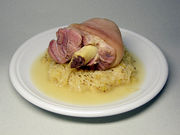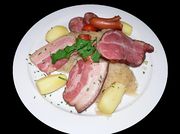Sauerkraut
Sauerkraut (pronounced /ˈsaʊərkraʊt/ in English; German pronunciation: [ˈzaʊ.ɐkʁaʊt] (![]() listen), Yiddish: [ˈzɔi̯.əʀ.kʀɔi̯t]), directly translated from german: "sour herb" or "sour cabbage", is finely shredded cabbage that has been fermented by various lactic acid bacteria, including Leuconostoc, Lactobacillus, and Pediococcus.[1][2] It has a long shelf-life and a distinctive sour flavor, both of which result from the lactic acid that forms when the bacteria ferment the sugars in the cabbage. It is therefore not to be confused with coleslaw, which receives its acidic taste from vinegar.
listen), Yiddish: [ˈzɔi̯.əʀ.kʀɔi̯t]), directly translated from german: "sour herb" or "sour cabbage", is finely shredded cabbage that has been fermented by various lactic acid bacteria, including Leuconostoc, Lactobacillus, and Pediococcus.[1][2] It has a long shelf-life and a distinctive sour flavor, both of which result from the lactic acid that forms when the bacteria ferment the sugars in the cabbage. It is therefore not to be confused with coleslaw, which receives its acidic taste from vinegar.
Contents |
Producing sauerkraut

Sauerkraut is made by a process of pickling called lacto-fermentation that is analogous to how traditional (not heat-treated) pickled cucumbers and kimchi are made. Fully-cured sauerkraut keeps for several months in an airtight container stored at or below 15°C (59°F). Neither refrigeration nor pasteurization is required, although these treatments may prolong storage life. However, pasteurization will destroy all of the beneficial digestive enzymes and lactic acid bacteria, as well as the valuable vitamin C content, so it greatly diminishes the nutritional value without any significant benefit.
No special culture of lactic acid bacteria is needed because these bacteria already are present on raw cabbage. Yeasts also are present, and may yield soft sauerkraut of poor flavor when the fermentation temperature is too high. The fermentation process has three phases. In the first phase, anaerobic bacteria such as Klebsiella and Enterobacter lead the fermentation, and begin producing an acidic environment that favours later bacteria. The second phase starts as the acid levels become too high for many bacteria, and Leuconostoc mesenteroides and other Leuconostoc spp. take dominance. In the third phase, various Lactobacillus species including L. brevis and L. plantarum ferment any remaining sugars, further lowering the pH.[1][2]
Health benefits

| Nutritional value per 100 g (3.5 oz) | |
|---|---|
| Energy | 78 kJ (19 kcal) |
| Carbohydrates | 4.3 g |
| Sugars | 1.8 g |
| Dietary fibre | 2.9 g |
| Fat | 0.14 g |
| Protein | 0.9 g |
| Water | 92 g |
| Vitamin B6 | 0.13 mg (10%) |
| Vitamin C | 15 mg (25%) |
| Iron | 1.5 mg (12%) |
| Sodium | 661 mg (29%) |
| Percentages are relative to US recommendations for adults. Source: USDA Nutrient database |
|
Raw sauerkraut is very healthful. It is an excellent source of vitamin C, lactobacilli, and other nutrients. However, the low pH and abundance of otherwise healthful lactobacilli may upset the intestines of people who are not used to eating acidic foods. Studies suggest that fermented cabbage may be even more healthful than the raw vegetable, with increased levels of anti-cancer agents such as isothiocyanates.
Before frozen foods and the importation of foods from the Southern hemisphere became readily available in northern and central Europe, sauerkraut provided a vital source of the aforementioned nutrients during the winter. Captain James Cook always took a store of sauerkraut on his sea voyages, since experience had taught him that it was an effective preventative of scurvy.[3][4] German sailors continued this practice even after the British Royal Navy had switched to limes, earning the British sailor the nickname "Limey" while his German counterpart became known as a "Kraut".[5]
It is now known that the preservation of sauerkraut in an anaerobic environment (in the brine) keeps the vitamin C in it from being oxidized. There is some evidence that indicates that kimchi, and by extension sauerkraut, may be used to treat avian influenza in birds.[6] Currently, there is no evidence of its effect on human cases.
Sauerkraut is also a source of biogenic amines such as tyramine, which may cause adverse reactions in sensitive people.[7][8] It also provides various cancer-fighting compounds including isothiocyanate and sulphoraphane.[9][10][11][12][13][14][15][16]
Similar foods
There are many other vegetables that are preserved by a similar process.
Also a feed for cattle, silage, is made the same way.
Cultural references
- During World War I, due to concerns the American public would reject a product with a German name, American sauerkraut makers relabeled their product as "Liberty cabbage" for the duration of the war.[17]
- The dessert known as sauerkraut candy is a variant of a fudge penuche that is made with coconut flakes. Most recipes for sauerkraut candy call for use of shredded coconut, and other ingredients such as cocoa, chocolate, caramel and marshmallow.
- In the "Weird Al" Yankovic song "Albuquerque", the narrator explains that he hates sauerkraut and his mother forces him to eat it until he was 26 and a half years old.
See also
References
- ↑ 1.0 1.1 Farnworth, Edward R. (2003). Handbook of Fermented Functional Foods. CRC. ISBN 0-8493-1372-4.
- ↑ 2.0 2.1 "Fermented Fruits and Vegetables - A Global SO Perspective". United Nations FAO. 1998. http://www.fao.org/docrep/x0560e/x0560e10.htm. Retrieved 2007-06-10.
- ↑ see http://www.mariner.org/exploration/index.php?type=webpage&id=55 / What did they eat? which begins "One of Cook’s most important discoveries..." and http://www.vitamindeficiency.info/?page_id=9 which additionally mentions "...citrus fruit such as lemons and lime. James Cook ...."
- ↑ Saloheimo P (2005). "[Captain Cook used sauerkraut to prevent scurvy]" (in Finnish). Duodecim 121 (9): 1014–5. PMID 15991750.
- ↑ Cambridge Encyclopedia:Scurvy Website Accessed 28 November 2009
- ↑ "BBC News — Korean dish "may cure bird flu"". 2005-03-14. http://news.bbc.co.uk/2/hi/asia-pacific/4347443.stm. Retrieved 13 February 2008.
- ↑ "British Nutrition Foundation". http://www.nutrition.org.uk/home.asp?siteId=43§ionId=776&parentSection=656. Retrieved 13 February 2008.
- ↑ "The European Food Information Council (EUFIC) : Your guide to food safety & quality and health & nutrition for a balanced diet and healthy lifestyle.". http://www.eufic.org/gb/food/pag/food28/food281.htm. Retrieved 13 February 2008.
- ↑ "RD - simple ways to prevent cancer". http://www.rd.com/health/cancer/31-simple-ways-to-prevent-cancer/article16072.html.
- ↑ Moret, Sabrina et al. (2005). "A survey on free biogenic amine content of fresh and preserved vegetables". Food Chemistry (Elsevier) 89 (3): 355–361. doi:10.1016/j.foodchem.2004.02.050.
- ↑ Pu, C. et al.; Xia, C; Xie, C; Li, K (November 2001). "Research on the dynamic variation and elimination of nitrite content in sauerkraut during pickling". Wei Sheng Yan Jiu 30 (6): 352–4. PMID 12561618.
- ↑ Wantke, F. et al.; Götz, M; Jarisch, R (December 1993). "Histamine-free diet: treatment of choice for histamine-induced food intolerance and supporting treatment for chronical headaches". Clinical & Experimental Allergy (Blackwell Publishing) 23 (12): 982–5. doi:10.1111/j.1365-2222.1993.tb00287.x. PMID 10779289. http://www.blackwell-synergy.com/doi/abs/10.1111/j.1365-2222.1993.tb00287.x.
- ↑ Ward, Mary H. et al.; Pan, WH; Cheng, YJ; Li, FH; Brinton, LA; Chen, CJ; Hsu, MM; Chen, IH et al. (June 2000). "Dietary exposure to nitrite and nitrosamines and risk of nasopharyngeal carcinoma in Taiwan". International Journal of Cancer (John Wiley & Sons) 86 (5): 603–9. doi:10.1002/(SICI)1097-0215(20000601)86:5<603::AID-IJC1>3.0.CO;2-H. PMID 10797279. http://www3.interscience.wiley.com/cgi-bin/abstract/72001571/ABSTRACT.
- ↑ Chang, Ellen T.; Hans-Olov Adami (October 2006). "The Enigmatic Epidemiology of Nasopharyngeal Carcinoma". Cancer Epidemiology Biomarkers & Prevention 15 (10): 1765–77. doi:10.1158/1055-9965.EPI-06-0353. PMID 17035381.
- ↑ Hung, Hsin-chia et al.; Huang, MC; Lee, JM; Wu, DC; Hsu, HK; Wu, MT (June 2004). "Association between diet and esophageal cancer in Taiwan". Journal of Gastroenterology and Hepatology 19 (6): 632–7. doi:10.1111/j.1440-1746.2004.03346.x. PMID 15151616. http://www.blackwell-synergy.com/doi/abs/10.1111/j.1440-1746.2004.03346.x.
- ↑ Siddiqi, Maqsood; R. Preussmann (1989). "Esophageal cancer in Kashmir — an assessment". Journal of Cancer Research and Clinical Oncology (Springer) 115 (2): 111–7. doi:10.1007/BF00397910. PMID 2715165. http://www.springerlink.com/content/q673338420ul2555/. Retrieved 8 November 2007.
- ↑ "Over Here: World War I on the Home Front". Digital History. http://www.digitalhistory.uh.edu/database/article_display.cfm?HHID=531. Retrieved 2006-07-12.
Bibliography
- USDA Canning guides, Volume 7
- "rec.foods.preserving FAQ". http://rfpfaq.jaclu.com/rfpFAQ.htm. Retrieved 2006-04-23.
- Aubert, Claude (1999). Keeping Food Fresh: Old World Techniques & Recipes. Chelsea Green Publishing Company. ISBN 1-890132-10-1.
- Fallon, Sally, with Enig, Mary G., Ph.D. (2001). Nourishing Traditions...[westonaprice.org; newtrendspublishing.com]. New Trends Publishing. ISBN 0967089735.
- Katz, Sandor Ellix (2003). Wild Fermentation: The Flavor, Nutrition, and Craft of Live-Culture Foods. Chelsea Green Publishing Company. ISBN 1-931498-23-7. http://www.wildfermentation.com/. Retrieved 2006-04-23.
- Kaufmann, Klaus (2001). Making Sauerkraut and Pickled Vegetables at Home. Book Publishing Company. ISBN 9781553120377. http://www.cc6582.hostcentric.com/public_html/bpc/products/making-sauerkraut.
External links
- Korean dish "may cure bird flu"
- Wild Fermentation recipe for making sauerkraut
- The Sauerkraut Fermentation described here
- Fermenting food since before H. sapiens appeared
|
|||||
